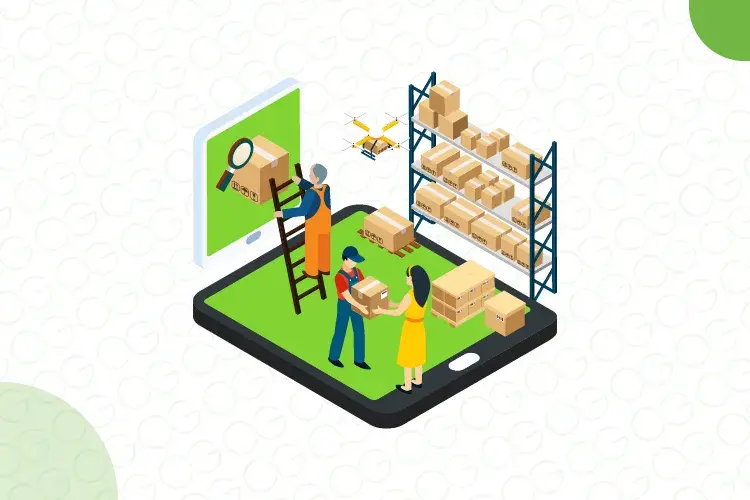Integrating WMS and Accounts: The Business Case for Retail ERP Software

As orders flood in from different sales channels, omnichannel retailers need to streamline the inventory and manage the transportation as well as the fulfilment of orders. Tackling the sheer volume of e-commerce marketplace orders alone can be baffling. However, when one adds orders from different stores, kiosks, and websites to the list of operations, it is impossible to run a mid-sized or large business without a Warehouse Management System (WMS).
An Overview of the WMS Market
Given the benefits of the software, it is no surprise that the WMS market was a whopping $3.94bn in 2023. As per the industry trends, this market is projected to grow significantly, clocking a spike of 19.5% CAGR between 2024 and 2030.
Worth mentioning that the cloud WMS is an interesting niche in the WMS market. As of 2023, most of the WMS deployments are those of cloud WMS. This segment of the WMS market is set to grow at 20.1% CAGR. The following are some of the major factors behind this impressive growth trajectory:
- The scalability and cost-effectiveness of cloud-enabled systems as opposed to hardware-based on-premises WMS
- Remote accessibility of the cloud WMS
- In-built cybersecurity measures in the cloud environment
- Regular updates
While there is no debate on the polarity of WMS, it is still important to consider why WMS are necessary when ERPs contain the entire venture’s data. Let’s probe

Leverage WMS today! Click Here
Why WMS and not just retail ERP software?
While a lot of businesses depend on Enterprise Resource Planning (ERP) for managing warehouses, achieving granular warehouse management is easier said than done with this generalist tool. ERPs can most certainly keep track of the inventory. But have you wondered what happens when for your order needs to be delivered to a distant brand outlet? How will you track the orders from one warehouse to another and then finally to the store? This is where a robust WMS will save the day.
Similarly, without a WMS integration getting bin-level visibility into the warehouse remains a challenge. Imagine a scenario where you need to urgently deliver an order and the ERP indicates that the item is one of the warehouses. This is where the trouble begins. Without knowing the exact location of the item, looking for it in a large warehouse is like looking for a needle in a haystack. Moreover, without detailed knowledge of the products and their whereabouts in the warehouse, conducting stock audits also can be difficult, making yet another case for the need for a solid WMS module which is linked to the retail ERP software.
Considering that WMS is central to retail management, in this blog we’ll discuss the benefits of integrating the tool into retail ERP, the central repository of enterprise data.
Benefits of WMS integration in ERP
When it comes to increasing the efficiency of retail management, the need for a single source of truth can’t be emphasized enough. This is because for business owners to get a holistic snapshot of their business they to see real-time data. Given that inventory is core to running one’s retail business, real-time data synchronization between the WMS and ERP is not good to have but a must-have. Needless to say, real-time data sync means the task is automated. This seamless process also eliminates human errors that come with manual intervention.
While accurate recordkeeping is the most evident benefit of WMS integration in ERPs, it is also the most important one. To elaborate, the retail ERP software data is used by owners to forecast revenue growth and this process requires the decision-makers to identify strengths and areas of improvement. Thus, the accuracy of the data that comes from warehouses is of paramount importance. This data, particularly the information surrounding the logistics details of warehouse-to-warehouse, warehouse-to-shipment, or warehouse-to-outlet movement of items is essential. Leveraging such minute data, the supply chain of the business can be optimised.
Forecasting growth also entails stock planning. While understocking can hamper order fulfilment timelines, thus hurting customer satisfaction, overstocking leads to mismanagement of funds and even revenue leakage if the item is perishable. Moreover, in the event of overstocking, the same capital could be used to purchase items that are more in demand and generate immediate returns. Only using the historical enterprise data, which is stored in ERPs, demand forecasting for upcoming seasons can be done. But will that suffice? The WMS data serves as a reference point for determining the quantity of stock that is required to be replenished. Thus, from the perspective of stocking and customer satisfaction, both of which are related to the revenue of the business, WMS integration in EPRs is necessary.
Similarly, apart from promoting informed decision-making the integration also streamlines order details of processing and packing with the rest of the business data. In that context, it is straightforward to imagine this scenario. An order comes and the WMS ERP integration helps you supervise the packing and shipment followed by order fulfilment.
However, the dynamic retail world is not this simple to navigate. Consider this alternative situation instead. While you are about to commit to fulfilling a bulk order early, meanwhile the marketing team of your business has also run a flash sale that has to be immediately delivered. Integrating WMS with ERP will alert you about the mismatch between the number of orders received and the inventory. In this case, the WMS and retailERP software coming together would prove to be the saviour. With the alerts, you can now prioritize the orders and stock up in time to serve both sets of parties without any hitch.
So, are you considering leveraging a WMS for better retail management? Then, holistic retail management suites such as the Ginesys One suite could be your answer. In this suite, the retail ERP software, Ginesys ERP comes with a robust WMS integration. Let’s take a deep dive into how Ginesys is helping retailers manage warehouses and accounts in an effortless manner.

Streamline warehouse management now!
Boosting Retail Management with Ginesys ERP and WMS
Ginesys ERP is one of our most sought-after retail management tools that comes with a robust WMS integration known as Ginesys WMS. This module of our retail ERP software has been designed to manage inventory, logistics, and supply chain operations. The data of warehouse management tasks is recorded by the WMS and instantaneously updated on Ginesys ERP and Ginesys One Order Management System (Browntape), the Ginesys One solution for multichannel retail.
We understand that businesses aspiring to hit a solid growth spurt need to stay connected with multiple locations to meet large volumes of orders efficiently. Our WMS efficiently manages inventory across warehouses. As a result, business owners can gain real-time stock visibility and optimise replenishment accordingly.
Ginesys WMS is also capable of handling large order volumes. Ensuring a streamlined order fulfilment process, the ERP module automates picking, packing, and shipping. The solution allows stock reservations and order tracking while showing real-time order status as well. Another unique feature of our solution is that being RFID-enabled, it empowers businesses to execute massive stock audits. Also, in terms of warehouse organization, the WMS is responsible for bin capacity tracking, and for merging and separating bins. Additionally, to ensure Ginesys WMS can be monitored and controlled remotely, we offer a user-friendly Android app.
However, there is still more to the benefits of Ginesys ERP’s WMS integration than we have discussed as well as when we compare the tool to several of its counterparts. Let’s find out!
Highlights of Ginesys ERP’s WMS Module
Here are some of the special capabilities of Ginesys WMS:
- Auto-posting of purchase records: As soon as goods are received, the WMS updates the ERP to avoid excessive purchases of goods. At the same time, for error-free accounting, the ERP integration ensures that discounts agreed upon during the deal are captured in the invoice.
- Managing inter-branch stock transfers: Our WMS automatically posts stock transfers between branches as inventory transfers and updates the stock information across the supply chain.
- Handling sales invoices and returns for e-commerce: The WMS creates a to-do list of collectables from payment gateways and courier partners as orders are executed and returned. Tallying sales invoices and returns from e-commerce, the solution helps ventures determine the net amount they need to acquire from payment gateways. Similarly, by setting alerts and tracking the recovery of returned items from courier partners, the solution further streamlines inventory. As the number of invoices and returns from ecommerce are huge, it is a real benefit to have your WMS integrated with your ERP.
- Keeping track of shipping charges: Integrating WMS with ERP automatically posts shipping charges on the ERP.
- Tallying B2B sales invoices and returns: While dealing with other businesses, the enterprise needs to ensure that the credit limits for orders are followed. In case the credit limit has been exceeded, the WMS blocks the shipping of excess goods. Similarly, it also syncs the returns and the sales invoices without any manual accounting, refreshing the credit limit with automatic credit notes.
Seeking a robust WMS and ERP combo? Book a demo with us. today!
